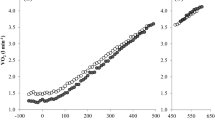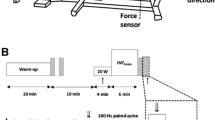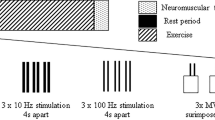Summary
The surface electromyogram (EMG) from active muscle and oxygen uptake (\(\dot VO_2 \)) were studied simultaneously to examine changes of motor unit (MU) activity during exercise tests with different ramp increments. Six male subjects performed four exhausting cycle exercises with different ramp slopes of 10, 20, 30 and 40 W · min−1 on different days. The EMG signals taken from the vastus lateralis muscle were stored on a digital data recorder and converted to obtain the integrated EMG (iEMG). The\(\dot VO_2 \) was measured, with 20-s intervals, by the mixing chamber method. A non-linear increase in iEMG against work load was observed for each exercise in all subjects. The break point of the linear relationship of iEMG was determined by the crossing point of the two regression lines (iEMGbp). Significant differences were obtained in the exercise intensities corresponding to maximal oxygen uptake (\(\dot VO_{2 max} \)) and the iEMGbp between 10 and 30, and 10 and 40 W · min −1 ramp exercises (P < 0.05). However, no significant differences were obtained in\(\dot VO_{2 max} \) and\(\dot VO_2 \) corresponding to the iEMGbp during the four ramp exercises. With respect to the relationship between\(\dot VO_2 \) and exercise intensity during the ramp increments, the\(\dot VO_2 \)-exercise intensity slope showed significant differences only for the upper half (i.e. above iEMGbp). These results demonstrated that the\(\dot VO_{2 max} \) and\(\dot VO_2 \) at which a nonlinear increase in iEMG was observed were not varied by the change of ramp slopes but by the exercise intensity corresponding to\(\dot VO_{2 max} \) and the iEMGbp was varied by the change of ramp slopes. In addition, the significant differences in the\(\dot VO_2 \) exercise intensity slopes for the upper half of the tests would suggest that the recruitment patterns of MU and/or muscle metabolic state might be considerably altered depending upon the ramp slope increments.
Similar content being viewed by others
References
Bangsbo J, Gollnick PD, Graham TE, Juel C, Kiens B, Mizuno M, Saltin B (1990) Anaerobic energy production and O2 deficit-debt relationship during exhaustive exercise in humans. J Physiol (Lond) 422:539–559
Coyle EF, Sidossis LS, Horowitz JF (1991) Muscular efficiency is related to muscle fiber composition (abstract). Med Sci Sports Exerc 23 [Suppl] S1-S170
Davis JA, Whipp BJ, Lamarra N, Huntsman DJ, Frank MH, Wasserman K (1982) Effect of ramp slope on determination of aerobic parameters from the ramp exercise test. Med Sci Sports Exerc 14:339–343
deVries HA (1968) Method for evaluation of muscle fatigue and endurance from electromyographic fatigue curve. Am J Phys Med 47:125–135
Donovan CM, Brooks GA (1983) Endurance training affects lactate clearance, not lactate production. Am J Physiol 244: E83-E92
Edwards RHT, Hill DK, Jones DA (1975) Heat production and chemical changes during isometric contractions of the human quadriceps muscle. J Physiol (Lond) 251:303–315
Farrell PA, Wilmore JH, Coyle EF, Billing JE, Costill DL (1979) Plasma lactate accumulation and distance running performance. Med Sci Sports 11:338–344
Fitts RH, Holloszy JO (1976) Lactate and contractile force in frog muscle during development of fatigue and recovery. Am J Physiol 231:430–433
Fuchs F, Reddy Y, Briggs FM (1970) The interaction of cations with the calcium-binding site of troponin. Biochem Biophys Acta 221:407–409
Gollnick PD, Piehl K, Saltin B (1974) Selective glycogen depletion pattern in human muscle fibers after exercise of varying intensity and at varying pedalling rates. J Physiol (Lond) 241:4557
Hansen JE, Casaburi R, Cooper DM, Wasserman K (1988) Oxygen uptake as related to work rate increment during cycle ergometer exercise. Eur J Appl Physiol 57:140–145
Helal JN, Guezennec CY, Goubel F (1987) The aerobic-anaerobic transition: re-examination of the threshold concept including an electromyographic approach. Eur J Appl Physiol 56:643–649
Hermansen L, Hultman E, Saltin B (1967) Muscle glycogen during prolonged severe exercise. Acta Physiol Scand 71:129–139
Horowitz JF, Sidossis LS, Coyle EF (1991) Muscle fiber type influences efficiency and performance (abstract). Med Sci Sports Exerc 23 [Suppl] S1-S170
Ivy JL, Wither RT, Handel PJ, Elger DH, Costill DL (1980) Muscle respiratory capacity and fiber type as determinants of the lactate threshold. J Appl Physiol 48:523–527
Jorfeldt L, Julin-Dannefelt A, Karlsson J (1978) Lactate release in relation to tissue lactate in human skeletal muscle during exercise. J Appl Physiol 44:350–352
Kumagai S, Tanaka K, Masuura Y, Matsuzaka A, Hirakoba K, Asano K (1982) Relationships of the anaerobic threshold with the 5 km, 10 km, and 10 mile races. Eur J Appl Physiol 49:13–23
Moritani T, Nagata A, Muro M (1982) Electromyographic manifestations of muscular fatigue. Med Sci Sports Exerc 14:198–202
Moritani T, Tanaka H, Yoshida T, Ishii C, Yoshida T, Shindo M (1984) Relationship between myoelectric signals and blood lactate during incremental forearm exercise. Am J Phys Med 63:122–132
Nagata A, Muro M, Moritani T, Yoshida T (1981) Anaerobic threshold determination by blood lactate and myoelectric signals. Jpn J Physiol 31:585–597
Nilsson J, Tesch P, Thorstensson A (1977) Fatigue and EMG of repeated voluntary contractions in man. Acta Physiol Scand 101:194–198
Petrofsky JS (1979) Frequency and amplitude analysis of the EMG during exercise on the bicycle ergometer. Eur J Appl Physiol 41:1–15
Petrofsky JS, Glaser RM, Phillips CA (1982) Evaluation of the amplitude and frequency components of the surface EMG as an index of muscle fatigue. Ergonomics 25:213–223
Sahlin K, Katz A, Henriksson J (1987) Redox state and lactate accumulation in human skeletal muscle during dynamic exercise. Biochem J 245:551–556
Sjogaard G (1978) Force-velocity curve for bicycle work. In: Asmussen E (ed) Biomechanics VI-A. University Press, Baltimore, pp 93–99
Sjodin B, Jacobs I (1981) Onset of blood lactate accumulation and marathon running performance. Int J Sports Med 2:23–26
Skinner JS, McLellan TH (1980) The transition from aerobic to anaerobic metabolism. Res Q Exerc Sport 51:234–248
Stegmann H, Kindermann W, Schnabel A (1981) Lactate kinetics and individual anaerobic threshold. Int J Sports Med 2:160–165
Tanaka K, Matsuura Y (1984) Marathon performance, anaerobic threshold, and onset of blood lactate accumulation. J Appl Physiol 57:640–643
Viitasalo JHT, Komi PV (1977) Signal characteristics of the EMG during fatigue. Eur J Appl Physiol 37:111–121
Viitasalo JHT, Luhtanen P, Rahkila P, Rusko H (1985) Electromyographic activity related to aerobic and anaerobic threshold in ergometer bicycling. Acta Physiol Scand 124:287–293
Vollestad NK, Vaage O, Hermansen L (1984) Muscle glycogen depletion patterns in type I and subgroups of type II fibers during prolonged severe exercise in man. Acta Physiol Scand 122:433–441
Wasserman K, Whipp BJ, Koyal SN, Beaver WL (1973) Anaerobic threshold and respiratory gas exchange during exercise. J Appl Physiol 35:236–243
Wasserman K, Beaver WL, Whipp BJ (1986) Mechanisms and patterns of blood lactate increase during exercise in man. Med Sci Sports Exerc 18:344–352
Author information
Authors and Affiliations
Rights and permissions
About this article
Cite this article
Takaishi, T., Ono, T. & Yasuda, Y. Relationship between muscle fatigue and oxygen uptake during cycle ergometer exercise with different ramp slope increments. Europ. J. Appl. Physiol. 65, 335–339 (1992). https://doi.org/10.1007/BF00868137
Accepted:
Issue Date:
DOI: https://doi.org/10.1007/BF00868137




